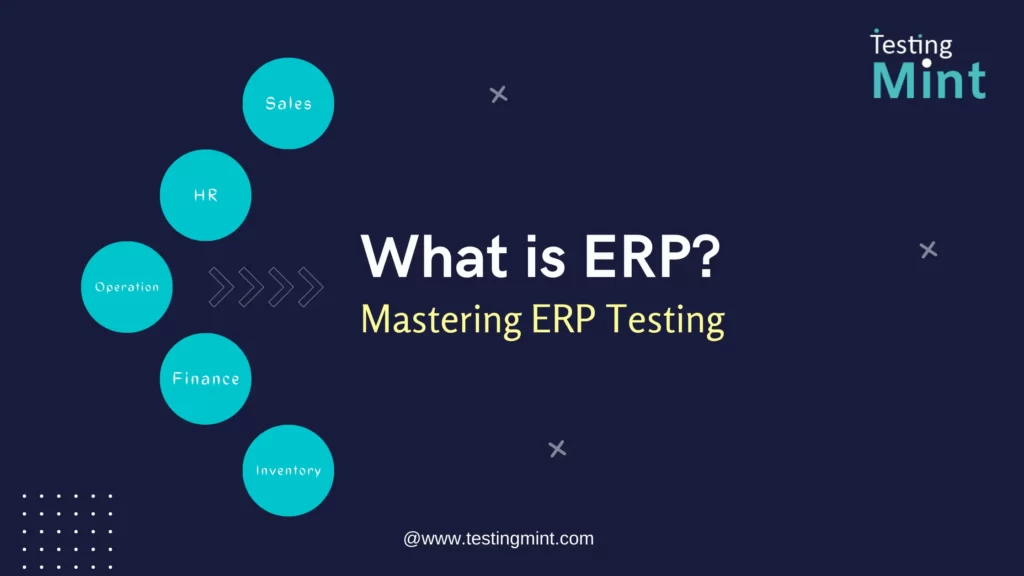In today’s fast-paced business environment, ERP systems have become a crucial tool for organizations to stay competitive and adapt to changing market conditions. It enables them to standardize their processes, gain visibility into their operations, and improve collaboration across departments.
However, implementing an ERP system can be complex, time-consuming, and expensive. Therefore, it is essential to perform thorough software testing to ensure that the system meets the organization’s requirements and functions as expected. In this blog, we will discuss about software testing in ERP systems to help you achieve a successful implementation.
Table of Contents
What is ERP?
Enterprise Resource Planning (ERP) is a business management software that integrates and automates various back-office functions, including financial management, supply chain management, inventory management, human resource management, and customer relationship management. ERP systems provide a centralized platform for managing and sharing data across different departments, enabling organizations to make informed decisions, improve collaboration, and increase productivity.
Features of ERP System:
- Integrated system:
ERP systems provide a single, unified platform for managing different business functions. - Real-time data:
ERP systems provide real-time access to data, enabling organizations to make informed decisions based on up-to-date information. - Modular design:
ERP systems are designed to be modular, meaning that organizations can select and configure the modules that meet their specific needs. - Customization:
ERP systems can be customized to meet the unique requirements of an organization. - Reporting and analytics:
ERP systems provide advanced reporting and analytics capabilities, allowing organizations to analyze their operations and performance.
Types of ERP Systems:
There are several types of ERP systems available, each with its own set of features, capabilities, and target markets. Following are some of the most common types of ERP systems:
- On-Premises ERP:
On-premises ERP systems are installed and run on the company’s own servers and computers. The company is responsible for maintaining and updating the software, as well as ensuring that the hardware and infrastructure are adequate to support the system. On-premises ERP systems are often used by larger companies with dedicated IT teams and resources.
Example: SAP ERP, Oracle ERP, Microsoft Dynamics GP
- Cloud ERP:
Cloud ERP systems are hosted and managed by a third-party provider and accessed over the internet. The provider is responsible for maintaining and updating the software and infrastructure, while the company only needs to pay for the services they use. Cloud ERP systems are often used by smaller companies that do not have the resources or expertise to maintain their own IT infrastructure.
Example: NetSuite, Acumatica, Epicor Cloud ERP
- Hybrid ERP:
Hybrid ERP systems combine on-premises and cloud-based components to provide a customized solution that meets the company’s specific needs. The on-premises components are typically used for core business processes, while the cloud-based components are used for specific functions such as customer relationship management (CRM) or human resources (HR) management.
Example: Microsoft Dynamics 365, SAP S/4HANA Cloud, Oracle Fusion Cloud ERP
- Industry-Specific ERP:
Industry-specific ERP systems are designed for businesses in specific industries, such as healthcare, manufacturing, or retail. These systems are tailored to meet the unique needs and requirements of the industry, and often include specialized features and functionality.
Example: Infor CloudSuite Healthcare, Plex Manufacturing Cloud, Oracle Retail
- Open-Source ERP:
Open-source ERP systems are built using open-source software and are freely available for anyone to use and modify. These systems can be customized and extended to meet the specific needs of the company, but may require more technical expertise to install and maintain.
Example: Odoo, ERPNext, Tryton
Benefits of using ERP System:
- Improved efficiency:
ERP systems automate routine tasks, reduce manual data entry, and streamline business processes, leading to increased efficiency and productivity. - Enhanced visibility:
ERP systems provide real-time data on all aspects of the organization’s operations, enabling better decision-making and planning. - Better collaboration:
ERP systems facilitate collaboration across different departments by providing a centralized platform for sharing data and communicating. - Increased accuracy:
ERP systems eliminate the need for manual data entry, reducing the risk of errors and improving data accuracy. - Cost savings:
By automating processes and increasing efficiency, ERP systems can help organizations save costs and increase profitability.
Software Testing in ERP System
ERP systems are complex software solutions that are critical to the operations of an organization. Therefore, it is crucial to perform comprehensive software testing to ensure that the system is functioning as intended and meets the organization’s requirements.
Importance of Software Testing in ERP System
- Ensures system functionality:
Software testing ensures that the ERP system is functioning as intended and meets the organization’s requirements. - Improves system performance:
Software testing identifies performance bottlenecks and helps optimize system performance. - Reduces risk:
Software testing helps identify and mitigate risks associated with the ERP system. - Enhances system security:
Software testing helps identify and address security vulnerabilities in the ERP system. - Increases user satisfaction:
By ensuring that the ERP system is functioning as intended, software testing improves user satisfaction and adoption.
Types of Software Testing in ERP System
ERP software testing involves various types of testing to ensure that the ERP system is functioning as expected and meets the user’s requirements. Following are the most common types of software testing used in ERP:
- Functional Testing:
Functional testing is used to test the functionality of the ERP system. It involves verifying that the system meets the functional requirements specified by the user. Functional testing is typically performed by creating test cases that mimic real-world scenarios and transactions.
Example: In an ERP system for manufacturing, functional testing may involve testing the creation of a new work order, updating the bill of materials, and generating production reports. - Integration Testing:
Integration testing is used to test the integration of different modules or subsystems within the ERP system. It involves verifying that data flows correctly between different modules and that the modules function as expected when integrated.
Example: In an ERP system for financials, integration testing may involve testing the integration of the general ledger module with the accounts payable and accounts receivable modules. - Regression Testing:
Regression testing is used to test the ERP system after changes have been made to the software. It involves verifying that the changes have not introduced new defects or affected the functionality of the system.
Example: In an ERP system for logistics, regression testing may involve testing the impact of a new software patch on the system’s shipping and receiving modules. - User Acceptance Testing (UAT):
User acceptance testing is used to test the ERP system from the end-user perspective. It involves verifying that the system meets the user’s requirements and is easy to use. UAT is typically performed by the end-users or a representative group of users.
Example: In an ERP system for customer relationship management (CRM), UAT may involve testing the system’s ability to track customer interactions, manage leads, and generate reports. - Performance Testing:
Performance testing is used to test the performance and scalability of the ERP system under varying conditions. It involves verifying that the system can handle large volumes of transactions and users without compromising its performance.
Example: In an ERP system for human resources, performance testing may involve testing the system’s ability to handle a large number of employee records, generate payrolls, and run reports. - Security Testing:
Security testing is used to test the ERP system’s security features and to identify vulnerabilities that could be exploited by hackers. It involves verifying that the system’s data is secure, encrypted, and protected from unauthorized access.
Example: In an ERP system for healthcare, security testing may involve testing the system’s ability to protect patient data, comply with data protection regulations, and prevent unauthorized access to the system.
Software Testing Approaches for ERP System
There are two main approaches to testing ERP software:
1. Manual Testing
Manual testing involves testing the ERP software manually, without the use of any test automation tools. This approach involves creating test cases, executing them manually, and verifying the results. Manual testing is typically used for testing the ERP system’s user interface, functionality, and usability. It is also useful for testing the system’s ability to handle real-world scenarios.
Manual testing can be time-consuming and labor-intensive, especially when testing large and complex ERP systems. However, it has the advantage of being more thorough and detailed compared to automated testing. Manual testing allows testers to identify subtle defects that may be missed by automated testing.
Examples:
- Testing the ERP system’s user interface to ensure that it is user-friendly and intuitive
- Testing the ERP system’s functionality to ensure that it meets the user’s requirements and expectations
- Testing the ERP system’s integration with other systems in the enterprise
- Testing the ERP system’s ability to handle real-world scenarios, such as high user loads, network failures, and data corruption
2. Automation Testing
Automation testing involves using test automation tools to automate the testing process. This approach involves creating test scripts, executing them using test automation tools, and verifying the results. Automated testing is typically used for testing the ERP system’s performance, security, and regression.
Automation testing can be faster and more efficient compared to manual testing, especially when testing large and complex ERP systems. It can also be more reliable and consistent compared to manual testing since it eliminates the risk of human error. However, automated testing may not be suitable for testing the ERP system’s user interface and usability since it requires human judgment and interpretation.
Examples:
- Performance testing to test the ERP system’s response time, throughput, and resource utilization
- Security testing to identify and address security vulnerabilities in the ERP system
- Regression testing to ensure that any changes made to the ERP system have not introduced new defects or impacted existing functionality
Challenges of Software Testing in ERP System
- Complexity:
ERP systems are complex and have multiple modules, making testing challenging. - Customization:
ERP systems can be customized to meet the unique requirements of an organization, making testing even more complex. - Data migration:
Migrating data from legacy systems to the ERP system can be challenging and may impact testing. - Integration:
ERP systems often need to integrate with other third-party systems, which can be difficult to test. - User acceptance:
End-users may have different expectations and requirements, making user acceptance testing challenging.
Tools for Testing ERP Systems
- Selenium
- HP Unified Functional Testing (UFT)
- IBM Rational Functional Tester
- Apache JMeter
- Appium
- SoapUI
- TestComplete
- Ranorex
- Tricentis Tosca
- Katalon Studio
Conclusion
In conclusion, Enterprise Resource Planning (ERP) systems are critical for businesses to manage their operations efficiently and effectively. However, ensuring that an ERP system is functioning correctly can be challenging. That’s where software testing comes in. Software testing plays a crucial role in ensuring that the ERP system performs as intended and meets the user’s requirements.

